

 |
 |
|
Hung by the heavens with black, yield day to night! Comets, importing change of time and states, Brandish your crystal tresses in the sky... William Shakespeare Henry V, I.i |
Bright comets are the most beautiful objects to grace the night sky, they can be the most spectacular of the transient phenomena and for me they are special. The truly 'great' comets can interrupt the well known star patterns with their sweeping tails extending across much of the entire sky. These objects offer something for everyone, satisfying for the naked eye observer while delivering a challenge for the most advanced deep sky veteran and astrophotographer, the magnitudes of the comets rise and fall often in an unpredictable fashion like variable stars but they are not stars. They creep along the starry background like asteroids and their ghostly tails often possess the eerie delicate structure of the aurora, its this unpredictable nature that allures me to these always welcome visitors to our skies.
At its most basic level comet observation is fun however with a little practice anyone can contribute observations of scientific value particularly when it comes to light curve development, accurate positioning work and tail studies. Professional telescope time is very limited so astronomers do not have the freedom to observe every comet in the sky on a nightly basis so this is the area where the work of the amateur astronomer is sorely needed.
On any given night there at least several faint comets within reach of moderate to large backyard telescopes and if you wait a little longer then one or more can fall within the grasp of smaller instruments. Within 1-2 years one comes along that can be easily seen in 7X50 mm or 10X50 mm binoculars and on average you can expect a naked eye comet to appear in the sky every 3-5 years. However once every decade or so a comet comes along that is so bright that it shakes the world of astronomy and gets the attention from the media all over the world. These great comets are not to be missed as they can and have profoundly affected the lives of many observers - I am one of those people!
In 1997 I got to see my first comet, a friend and I had been driving through the country when I asked him to pull up at the side of the road to admire the night sky which from here was very dark and transparent. The night was crisp and cold with a heavy covering of frost carpeting the country road, this was a classic Winter's night. I glanced to the eastern sky where something bright and ghost-like hung in the sky with a broad glowing tail. It looked like a search beam pointing upwards however there were no light source out here. After the shock my friend answered my unspoken question - it was comet Hale-Bopp he said, after all it had been on the news and television for weeks. What a sight it was!! the emotions I felt were similar to how the ancient sky watchers must have felt as I stood there in disbelief - I couldn't decide whether to admire or fear it. This was my first ever comet sighting and it affected me very deeply. The visual impression and the upsurge of emotions the comet triggered was a catalyst that immediately changed my life. Now comets are my main observing target and passion within astronomy. This comet 'impact' began in 1997 and is now in full swing today as I write these words. Comets are double edged swords, they are responsible for mass extinctions on earth and may have delivered the ingredients that led to the formation of life on earth too so remember when you observe a comet you are observing your very own ancestors!
Comet designations are easy to understand. First we have either a letter 'C' or 'P' followed by a forward slash. 'C' stands for a long period comet (a comet with an orbital period greater than 200 years) and 'P' stands for a short period comet (orbital period less than 200 years) and more rarely we may see the letters 'D' and 'X' were 'D' represents a comet which has disappeared or died (eg: SL-9) and 'X' for those which have orbits that cannot be computed due to a lack of observations/positions.
Next comes the year of discovery then a space followed by a letter (see table below). The letter indicates the half month of discovery. The letters from A to Y are used however the letters I and Z are omitted for obvious reasons. Next is a number which indicates the order of discovery in that half monthly period. Lastly we have the name of the discoverer(s). Up to three names can be included if a comet is discovered and reported before it is officially announced. Example: C/2004 Q2 Machholz or 73P/Schwassmann-Wachmann.
A |
January 1 - 15 |
B |
January 16 - 31 |
C |
February 1 - 15 |
D |
February 16 - 29 |
E |
March 1 - 15 |
F |
March 16 - 31 |
G |
April 1 - 15 |
H |
April 16 - 30 |
J |
May 1 - 15 |
K |
May 16 - 31 |
L |
June 1 - 15 |
M |
June 16 - 30 |
N |
July 1- 15 |
O |
July 16 - 31 |
P |
August 1 - 15 |
Q |
August 16 - 31 |
R |
September 1 - 15 |
S |
September 16 - 30 |
T |
October 1 - 15 |
U |
October 16 - 31 |
V |
November 1 - 15 |
W |
November 16 - 30 |
X |
December 1 - 15 |
Y |
December 16 - 31 |
It is important to highlight here that comets are generally fainter objects to observe in comparison with a deep sky object of similar magnitude. If you can glimpse a galaxy at magnitude 14 then you may be surprised to learn that a magnitude 14 comet will be completely out of your scopes reach. This is because the light of a comet can be spread out over a larger area giving it a very low surface brightness. This is the reason why even a bright comet can succeed in slipping you by. Comet observer David Levy recalls missing a 7th magnitude comet with his 16" reflector simply because the comet had a very low surface brightness so watch out for these kind of interlopers. Below is a table showing comet magnitude Vs aperture for a given telescope under a dark sky.
Aperture (mm) |
Limiting Magnitude |
50 |
8.0 |
80 |
9.5 |
150 |
11.0 |
200 |
12.0 |
300 |
13.5 |
400 |
14.5 |
Your location is an important factor and will greatly influence the number of comets you can observe. The ideal location is a very dark rural site away from any light pollution and with a panoramic view down to the horizon. Even very bright comets may be difficult if they are close to the sun as they never get high in the sky and lurk within the bright evening or morning twilight skirting the horizon. A transparent sky is important - more so than having good seeing conditions. Stars to magnitude +6.0 should be visible with the naked eye.
Cometary observations should only be undertaken in a dark, moonless, clean sky. Observers should compliment their telescopic observations with binocular and naked eye work. Not everyone has the perfect location but we have to make do with the best we have, simple techniques like good dark adaption, patience and averted vision go a long way. Some deep sky observers place a 'light shroud' over their head and eyepiece to cancel out stray light. The famous visual observer Stephen James O’ Meara uses a method of deep breathing to oxygenate the brain and therefore enhancing visual acuity resulting in a gain of +1 magnitude. Tapping the telescope tube works well too as the human eye is better at detecting moving objects rather than stationary ones.
Ok so you plan to set your telescope up when it gets dark but how do you know if there are any comets visible from your location? This is were the internet comes in handy. I suggest visiting the following web sites...
These sites will tell you which comets are visible from your location. After you have chosen your comet of interest eg: (Q2 Machholz) then click on its ‘Ephemerides’.
This is a table which includes information of the comets RA and DEC, its predicted magnitude, current elongation from the moon and sun for every night during each month of its apparition. Then it is a simple matter of plotting the comets position on a good star atlas like ‘Sky Atlas 2000 or Uranometria (the latter is favored by comet observers). If you plot its position for several nights (preferably five) then you will get a good mental picture of it's speed and direction of movement during that time. If the comet is at a respectable distance (elongation) from the sun and is above the horizon then you can begin to track it down. I prefer to point the telescope at the section of the constellation the comet is located in then complete a little systematic search using a low magnification wide field eyepiece. Others may be more comfortable with the traditional technique of star hopping yet others will be inclined to use a Go–To telescope which is absolutely fine if you are having difficulty or are rushed for time. I personally encourage the manual approach for two reasons…
1) When you do find the comet you will get an unmistakable thrill as you have successfully tracked it down yourself. A process which feels very satisfying and will teach you the sky in a way you will never forget. (This feeling of satisfaction is absent with a Go-To).
2) You never know what you might find along the way (this applies to all types of observing), amateurs have found new comets and novae before while tracking down other objects. Eg: in recent times Vance Petriew discovered Comet Q2 Petriew while star hopping to the Crab Nebula (Messier 1 in Taurus). However you are more likely to accidentally find a new galaxy or binary star you have never seen before enriching your observing experience.
If the comet is brighter than magnitude +8.0 it may already be visible in your finder scope but if not then scan the eyepiece field for a faint fuzzy patch of light - that is your comet. It is important to remember that the ephemerides may be inaccurate for a newly discovered comet if there has been a lack of accurate astrometric positions to nail down its orbit and as such your target may be a little way from its predicted position so it pays to sweep around a little. Even well known periodic comets have been known to drift from their locations due to non–gravitational forces so bare this in mind.
Comet observation is split into two main areas. Those concerned with the ‘Coma’ and those concerned with the 'tail/s' respectively. Now I will concentrate on the coma. The ‘degree of condensation’ or D.C for short is a way of gauging how condensed the coma is. In a more specific manner it provides a visual description of the coma intensity across distance. It runs on a scale from 0 to 9…
0 = Diffuse coma of uniform brightness
1 = Diffuse coma with slight brightening towards center
2 = Diffuse coma with definite brightening towards center
3 = Centre of coma much brighter than edges, though still diffuse
4 = Diffuse condensation at centre of coma
5 = Condensation appears as a diffuse spot at centre of coma – described as moderately condensed.
6 = Condensation appears as a bright diffuse spot at centre of coma
7 = Condensation appears like a star that cannot be focused – described as strongly condensed
8 = Coma virtually invisible
9 = Stellar or disk like in appearance.
If your estimate is between two values say 3 and 4 then it is recorded as 3/. Do not confuse the central condensation with the degree of condensation. This is where confusion arises to beginning comet observers. A central condensation is a distinct brightening or disk within the coma. A condensed comet need not have a central condensation. One example is A2 LINEAR which went into outburst over the winter. The coma was a featureless patch of light, completely uniform in brightness with absolutely no central condensation. An inexperienced observer would rate the DC as 0 however it actually had a DC of 9 because the coma's edge was completely sharp like a planetary disk. Confused?...don't worry, with practice you will get better estimates. The best thing to do is to just try it yourself and compare your results to those of other observers on the above web sites. Eventually it will become second nature.
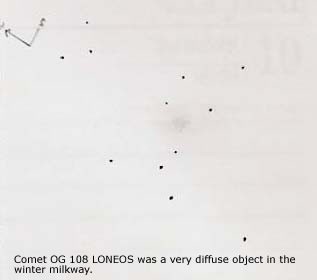 |
 |
 |
Above are three sketches. Top is an example of a moderately diffuse comet (OG108 LONEOS) middle is a moderately condensed comet (C/2002 C1 Ikeya–Zhang) and below is a very condensed comet (C/2002 V1 NEAT). Other things to record are…
What shape is the coma? Is it circular, elliptical, parabolic or elongated? Elongation could be an indication of comet break up which happened to 73P/ SW3 in May 2006 to spectacular effect.
Is the central condensation placed at the centre of the coma? A closer inspection may reveal it is not symmetrically placed but rather off-centre.
What colour is the coma? Most faint comae are a pastel grey colour while others are an obvious blue or green. Some brighter comets near perihelion have displayed gold colours due to sunlight scattered by dust within the coma and tail.
Is there a false nucleus? this is not to be confused with the central condensation. The false nucleus is a star-like body deep within the coma or central condensation. This is known as the false nucleus because the true nucleus is hidden from view by sunlight reflecting off dust particles issuing from the true nucleus which obscures our view. There are no confirmed observations of the true nucleus either visually or with super sensitive CCD devices although there have been claims in the past that have not been confirmed. Some comets have a false nucleus and some don’t. Take note of its position within the coma, its colour and brightness. Magnitude estimates of the false nucleus are valuable and are known as M2 magnitude estimates (you will most likely need a CCD imager for this) were M1 refers to the total visual magnitude of the coma.
A simple way to measure the diameter of the coma is by knowing the field of view of each eyepiece. This technique is not very accurate however it is simple and is a good place to start. Eg: using my 32mm SWA eyepiece in conjunction with my 16” F/4.5 reflector I know the FOV is 1 degree or 2 full moon/sun diameters (I have obtained this value at an earlier period) which is 60’ or 60 arc min's. If the coma of a comet takes up ¼ of the FOV then I can estimate that the comet has a coma diameter of 15’ or half the size of the full moon.
Another more taxing method is to measure the coma diameter by estimating its length in relation to nearby field stars then using a detailed star atlas to work out its size.
The third method is the ‘drift method’ and it is the one I use for my own estimates. Simply time how long it takes for the coma to drift out of the FOV along the east– westline, if you have a motor drive on then switch it off. Stars will disappear out of the FOV to the west and new stars will drift in from the east. Using the following equation the coma size can be estimated with good accuracy...
D = 15t cos delta where D is the east = west time span
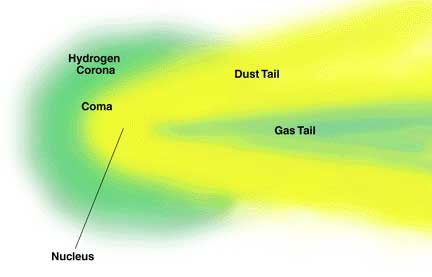 |
There are other more intricate details hidden within the coma that may not be obvious at a first glance however by being aware and familiar with them in advance you may pick them out especially on an active or bright comet. These include...
Which are often seen concentrically placed around the central condensation.
Fans are sectors of material emanating from the central condensation
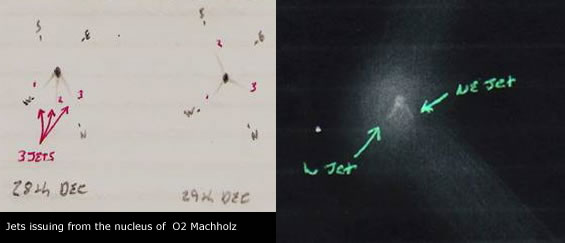 |
Radial features projecting from the central condensation either as straight lines or curved and are most prominent in active or very close/large comets. Hale–Bopp is a classic example however several observers spotted these in the recent C/2004 Q2 Machholz.
Bright, sharp, narrow streaks leading from the central condensation into the tail.
Delicate strips of light coming from the central condensation, usually a soft white/grey or blue colour.
Not really a shadow as such but looks that way visually. According to the BAA observing guide to comets it is rare and needs a 16” or larger instrument to be seen easily.
Fountains are around 1’ high in the sunward direction. They are diffuse features substending a few to 100 degrees angle and are more common than jets.
This is an area were the amateur observer can contribute important data of scientific value. If you have experience in the field of variable star observation then comet magnitude estimates should present no problem however to a beginner this area of comet photometry can seem daunting and complicated but with a little practice you can obtain data of scientific value in no time. There are various methods employed eg: the in–out method, out–out method, modified out method, and the Beyer or extra focal Extinction method. For the purpose of this article I will choose one.
1) Study the coma until you are familiar with its average brightness. This is easy if the entire coma is uniform (has a low degree of condensation or D.C) but not so easy if the coma sports a highly developed central condensation.
2) Using an atlas that shows star magnitudes, find a comparison star at about the same altitude and, if possible, in the same part of the sky as the comet.
3) Throw the star out of focus so that it is the size of the in–focus coma.
4) Compare the stars out of focus brightness with that of the in–focus coma.
5) Repeat steps 2, 3, and 4 with more stars, until you have a star less than half a magnitude brighter than the coma and a second one less than half a magnitude fainter than the coma.
6) Interpolate between the 2 stars to assign the coma its magnitude.
Do not be intimated by this and gave it a go. With constant practice you will become very proficient and will have developed a very useful observing skill that can be used throughout your own observing lifetime.
Things to remember – because of the little understood phenomena of ‘aperture affect’ one should use the smallest optical aid needed to see the comet in order to obtain an accurate magnitude estimate. Example: a 16” telescope should NOT be used to make an estimate of a mag +8.0 comet! instead a good pair of binoculars would be a more efficient tool and would be more user friendly for this work because of their larger fields and the ability to throw stars out of focus quickly with a touch with your finger or thumb. Many enthusiastic comet observers have in their possession a full range of equipment from binoculars to medium and large aperture telescopes. Consider a very bright naked eye comet like Hyakutake, binoculars would give an untrustworthy magnitude estimate, you can see the coma with your naked eye but how can you defocus your eyes to make your own estimate? Surely the suggestion sounds ridiculous? Well there is one way that is not well known among observers, a neat trick that is as yet unnamed. Imagine standing under a clear starry night with a bright comet in front of you. Hold your finger or thumb out in front of you. If you lift your gaze from the background stars onto your thumb you will make the stars become out of focus. By shifting the distance between your eyes and your thumb you can adjust how far out of focus you want the stars to be. With a little concentration you can find bright naked eye comparison stars and interpolate between them as mentioned above to make your own magnitude estimate – simple but it works!
Try to find suitable comparison stars that are placed nearby and at the same altitude as the comet. Choosing one star at the zenith and a second near the horizon is not good practice and should only be used if no other choice is available. More advanced observers apply an equation which corrects for atmospheric extinction when a comet is placed low in the sky close to the horizon which cancels out and corrects the effects of the comparison stars low altitude in thick atmosphere, I like to think of this as a funny kind of adaptive optics with a calculator. As a last pointer avoid using red comparison stars which have a tendency to build up on the retina and appear brighter than they truly are. These chameleon stars produce what is called the ‘purkinjie affect' on an observer and as such should be avoided.
Finally NEVER be influenced by other observers magnitude estimates, do not be tempted to edit your own estimate because other observers have results that differ from yours. After all you might have the only correct one and the magnitudes produced on the ephemerides are the predicted magnitudes. More often than not these are not accurate so your own estimates may be imperative if few observers have been following your chosen comet. If you stick to lease guide lines then you will be producing high quality magnitude estimates in no time!
The tail is the most distinctive feature that comes to mind when you mention the word ‘comet’ to anyone. Comets have 2 distinctive types of tails…
|
The most prolific type of tail to many visual observers. Type II dust tails are normally the brightest type of tail to observe. They are composed of dust particles that reflect sunlight and can appear curved as each individual dust particle follows its own leisurely orbit around the sun in the wake of its parent nucleus. Dust tails can vary from faint to very bright depending on how active and dusty a comet is and its elongation from the sun and its perihelic distance. They often appear a grey pastel colour like the coma or a bright white or even a lovely yellow/gold caused by the reflection of sunlight. Through binoculars and telescopes they are typically uniform in brightness and texture however very active or ‘great’ comets may exhibit what is known as ‘synchronic bands’. These are bright sections of bands within the dust tail that are caused by episodic outbursts of active jets of dust from the rotating nucleus that can look spectacular to anyone who has been privileged enough to witness such a scene. Great comets Hale–Bopp (1997) and West (1976) are classic examples. (Left) sketch of the dust tail on S4 LINEAR). |
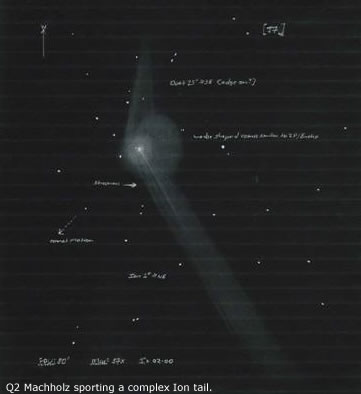 |
Type 1 ion tails are also known as gas or plasma tails. These type of tails are much more elusive and subtle than their dusty counterparts. They always are straight and point directly away from the sun and exhibit a beautiful electric blue colour.
Observing this type of tail requires a very transparent dark sky; they are seldom seen with the naked eye and are best observed visually through binoculars or a telescope. They are very dynamic and can change dramatically in a short period of time often displaying some very intricate details like...
Bends or twists that can be seen to move downwind through the tail by the solar wind over a period of several hours however these are best seen on photographs and CCD Images.
Delicate thin blue lines of gossamer that emanate from the coma running straight down the gas tail, they can be numerous, very long and be seen superimposed on the dust tail. They are truly a lovely sight and best seen in binoculars. You could almost swear you could see them dancing in real time in the solar wind.
 |
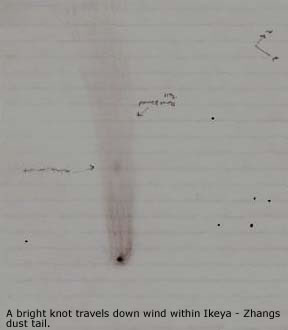 |
If you are vigilant enough you may catch a glimpse of a dark patch or knot of material move downwind through the tail. Believe me you will know such an event if it appears as it clearly stands out. The only time I have seen this happen was while observing comet Ikeya–Zhang in 2002 with my 8” SCT at 49X, I was very surprised and excited to say the least!
These are best seen with a succession of CCD images but are very rare to see visually unless you are vigilant and an experienced observer with excellent sky conditions. DE’s are caused by a change in direction of the solar wind. Ion tails are like weather vanes in the solar system showing astronomers the secrets of the solar winds clandestine behavior!
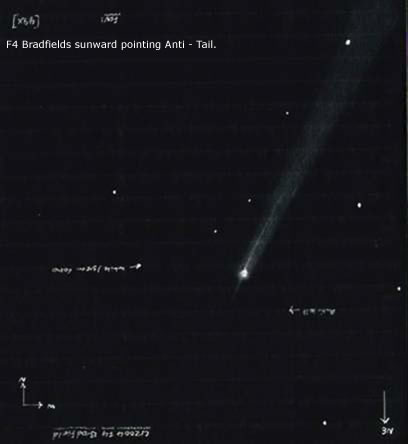 |
These have got to be one of the finest elusive sights in nature. The anti–tail or ‘anti–solar’ tail is a trick of perspective which happens when the Earth passes through the plane of the comet's orbit, the Earth based observer is witnessing sunlight reflecting off dust particles that appear to extend in front of the coma pointing towards the sun instead of away from it. The most famous example of this was the spectacular anti–tail on the bright comet Arend–Roland in 1957. In 2004 I was lucky enough to see my very first and to date only anti–tail on a comet. I was observing the unexpected spectacular comet F4 BRADFIELD in the morning sky when all of sudden I spotted a lovely 5’ long spike of ghostly light extending out from the coma in the sunward direction. I was utterly amazed because on the previous morning it was not there!, as it turned out I was the only person from Ireland to see it and I learned via the MPML that only a handful of other observers throughout the world seen it also and confirmed it on CCD images. I will not forget that morning!
Watching a comet move among the background stars can be a very pleasing experience. It helps to have one or more field stars near the coma which will help you detect movement more easily compared to a field with a sparse number of stars. The time it takes to detect comet motion can vary widely depending on the comets distance from the Sun and Earth. Hale–Bopp was a very large active comet but it did not pass anywhere near the Earth and so its movement was not as impressive as comets that grazed the Earth so to speak like comets Hyakutake and Iras–Araki–Alcock. The latter comet is on record for making the second closest approach from any known comet. Comet Lexell currently holds the record. These three comets could be seen moving rapidly even with the naked eye and made astrophotography very difficult as imagers had to guide accurately on the fast moving nuclear region in real time during a time exposure!
Comets in prograde motion move in the same direction as the Earth similar to asteroids at speeds in excess of 40km/sec however (asteroids have slower velocities) many long period comets move in a retrograde motion against the motion of the Earth around the Sun and can generate speeds of up to 72km/sec…that’s 72 times faster than a bullet fired from a high velocity rifle! Keeping this in mind really brings to life any comet motion you detect. During a Winter observing night a number of us watched comet Q2 Machholz move in near real time within the telescopic FOV when the comet was at perihelion. Another thing to watch out for are comet transits across field stars. I fondly remember S4 LINEAR moving swiftly across field stars one bright Summer’s night. I could actually see the stars dim in real time as the comet's wedge-shaped dust tail passed in front of them. What a sight!
Comet tail lengths are defined in degrees and minutes of arc just like the coma diameter measurements. For naked eye and binocular tails you can estimate their length using a good star atlas and by how far the tail extends in relation to naked eye stars. It pays to be careful. Some fan shaped naked eye tails appear to ‘cut off’ at some distance from the coma while others may become faint and diffuse as they blend into the sky background. With a dark transparent sky and proper dark adaption you may be surprised to detect the tail extending much further than previously thought although sky conditions and the observers visual acuity come into play. I fondly remember seeing a blue ion tail 5 degrees long with the naked eye on comet Machholz with a gibbous moon in the sky. It was sky transparency and patience that enabled me to detect it. At the end of the day (or night should I say) it will depend on your own observing location. Basic sky watching techniques can be used for quick estimates on a naked eye comet. If you extend your arm in front of you then you can determine your own angular measurements in degrees without any optical aid…
1) Your little finger equates to 1degree
2) Your thumb covers approx 2 degrees
3) Three fingers at arms length equals 5 degrees of angular diameter
4) A fist expands 10 degrees of sky
5) Your thumb and little finger will extend to 20 degrees
As mentioned earlier, do not be tempted to alter your estimates if they do not compare favorably with those from other observers. Unbiased observations are important in any area of science. For more accurate tail measurements use the same techniques that apply for the coma diameter like the ‘drift method’ etc. Faint comets may possess very faint tails that will require a high magnification/wide field eyepiece to enlarge the image and induce a darker background sky. Tapping the telescope tube may reveal a faint extension from the coma or if there is a notable breeze then nature will do this for you. Pay close attention to what the tail tells you about itself. Is it straight or curved? Does it have soft or sharp edges? how many tails can you see? are there two tails visible at the same time?, one of gas and one of dust, determine their angle of separation and note details of both. You may get one tail superimposed on the other, the ion tail is placed in front of the dust tail our vice versa however it will depend on the Sun–Earth–Comet geometry at that period of time. Watching a tail grow can be an exhilarating experience, that tiny faint streak will change its morphology and position angle (see next section) as it approaches and rounds the Sun constantly changing with our Earthly viewpoint. Comet tails are typically at their longest during the post-perihelion period and the change can happen fast! When Hyakutake was discovered in 1996 it looked like a featureless patch of light. Within a matter of weeks it sported a spectacular ion tail 110 degrees long with the naked eye. Can you imagine that? a tail 220 moon diameters long! That’s the excitement of comet observation, they are transient, unpredictable, rogue swords in the sky and no one can tell you in advance just what they will do!
The position angle or PA is the terminology used to describe the angle at which the tail or tails leave the coma in relation to the set compass positions within the FOV. The PA begins with 0 degrees for north increasing through 090 degrees for east then to 180 degrees for south, 270 degrees for west and finally to 0 degrees (360 degrees) once again. It is simple and requires no fancy equipment. Use the drift method to obtain the east–west line as accurately as you possibly can, with this done and with the scopes inverted image (many scopes have south as up) I can get started very quickly. For the sake of simplicity lets say the east–west line is horizontal and level in the FOV, if the tail points straight down then I know it is pointing to the north at PA 0 degrees, if the tail is to the right (new stars enter the FOV from the east) then I know it is pointing to the east at PA 090 degrees. By refining it with trial and error you will get more accurate results. If you sketch the tail in relation to nearby stars and use a detailed star atlas then you can work out the PA from it too. An illuminated reticule eyepiece can prove very useful here. Note that for highly curved dust tails the PA would need to be noted at various points along the curve.
I hope this article has been of help to anyone who is interested in taking up comet observation either as a fun past time or for serious observation. I have outlined much of the basic and intermediate type of work an amateur astronomer can do and I hope it will give you a taste of what comet observation has in store. The information I have supplied is just the tip of the iceberg an amateur can do to contribute quality observations to enhance our knowledge on comets as a whole. It has been a joy for me to write this article and even more of a joy for me to observe these incredible, beautiful wanderers of the night sky. I will leave you with these words from comet hunter Leslie Peltier...
''Time has not lessened the age old allure of the comets. In some ways their mystery has only deepened with the years. At each return a comet brings with it the questions which were asked before, and as it rounds the sun and backs away toward the long, slow night of its aphelion, it leaves behind with us those same questions, still unanswered. To hunt a speck of moving haze may seem a strange pursuit, but even though we fail the search is still rewarding for in no better way can we come face to face, night after night, with such a wealth of riches as old Croesus never dreamed off ''